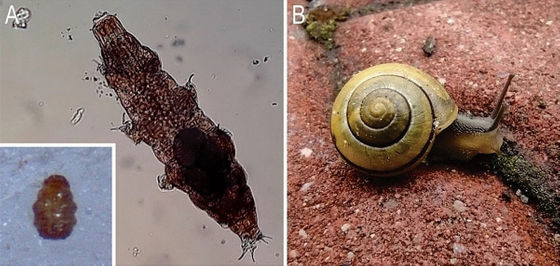It turns out that the strongest creature, the tardigrade, rides on a snail to expand its territory, but it's a dangerous journey that's bordering on death

Experimental evidence for snails dispersing tardigrades based on Milnesium inceptum and Cepaea nemoralis species | Scientific Reports
https://www.nature.com/articles/s41598-022-08265-2
Tardigrades may hitchhike on snails... and then suffocate in their slime | Live Science
https://www.livescience.com/tardigrades-hitchhike-on-snails
Tardigrades are microorganisms with a body length of 0.05 to 1.2 mm that live widely in water and on moss. When placed in a dry environment, they shrink their bodies into a 'tun' shape. This ability, called cryptobiosis , allows tardigrades to survive harsh environments for long periods of time, such as when a puddle dries up, and also allows them to ride the wind to move to another location. However, there is no guarantee that the environment where the tardigrades move is suitable for their habitation and reproduction.
Zofia Książkiewicz and Milena Roszkowska, biologists at Adam Mickiewicz University in Poland, focused on the ability of microorganisms to ' hit the road ' when traveling long distances. In particular, snails live in close proximity to tardigrades and have moist body surfaces, which are favorable conditions for tardigrades, so they hypothesized that 'snails may be the optimal means of transportation for tardigrades.'
To test this hypothesis, Książkiewicz and his colleagues collected two active snails, the wood snail and the tardigrade, which live in humid areas of Western Europe, and observed them in the same environment.
Specifically, they had snails slide over drops of water or moss containing tardigrades, and counted how many tardigrades could move on the snail. Below, A is a photo of the tardigrade Milnesium inceptum used in this experiment and its tun state, and B is a photo of the forest snail in its natural environment.

As a result of the experiment, 38 tardigrades attached themselves to the snail's body from the water droplet and 12 from the moss, and it was confirmed that they traveled long distances in a short time. From a human perspective, the slow-moving snail may not seem like a very good means of transportation, but the research team points out that for small microorganisms, even a movement of just a few centimeters is enough to improve genetic diversity between groups.
On the other hand, it was also found that piggybacking on snails is a risky method of transportation for tardigrades. When the research team conducted an experiment in which they dried tardigrades covered in snail mucus and then rehydrated them, the control group of tardigrades that were not covered in mucus were able to revive with a 98% success rate, while only 34% of the tardigrades covered in snail mucus were able to revive. The research team speculates that the reason for this is that 'tardigrades in the tun state that were temporarily revived by the moisture of the snail mucus were unable to return to the tun state properly even when the mucus dried, and instead solidified in an incomplete state.'
Regarding these results, the research team wrote at the end of the paper, 'Our experiments suggest that snail-tardigrade interactions may have both positive and negative effects on tardigrades. While snails proved to be a means of transportation for tardigrades, the high mortality rate of tardigrades that had dried after the mucus had been applied to them also revealed that snail mucus may have a harmful effect on tardigrades.'

Related Posts:







